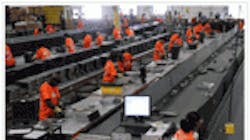Lean manufacturing practices continue to play an important role in today’s uncertain economic times, yet many want to move beyond lean manufacturing alone and take operational efficiency to a higher level. One proven way to do it is through a well-executed approach to production logistics. With the right approach, manufacturers stand to save millions and gain a competitive advantage. The key is to understand the value production logistics delivers and how to turn the concept into reality.
It’s about inventory control and streamlining
Production logistics is a relatively simple concept. It combines the use of technology and disciplined processes to ensure each machine and workstation is fed with the right product in the right quantity and quality at the right time. The goal is to gain more control of inventory from the time it arrives on site until it reaches the point of use—while streamlining the flow of materials to the assembly line.
Production logistics addresses the need to move beyond traditional methods to improve operational efficiencies—and reduce overall supply chain costs. The need to cut supply chain costs is echoed in IDC Manufacturing Insights’ 2012 U.S. Supply Chain Survey. According to the survey, manufacturing’s No. 1 supply chain priority is to reduce overall supply chain costs.
When properly planned and executed, production logistics lowers the cost of getting products from storage through production and on to the desired destination. It specifically alleviates bottlenecks that form when manufacturers use decades-old practices to control the flow of materials from a storage warehouse or loading dock to the production line. Often, production logistics involves a combination of automation and a laser focus on the processes involved.
Cutting costs to the tune of millions
A major Midwest manufacturer decided several years ago to improve its approach to production logistics. The $25 million-initiative illustrates how a commitment to operational improvement and vested partnerships create tangible and meaningful results.
At the manufacturing plant, production slowdowns and high inventory costs pointed to inefficiencies of inbound materials and the flow of materials to assembly lines. An extensive study pinpointed the main challenges:
• Multiple inbound storage facilities. Before reaching the production line, inbound materials were routed to separate facilities including a warehouse operated by a transportation supplier, a second warehouse operated by a 3PL and a third warehouse managed by the manufacturer. Multiple facilities drove up freight costs and created inefficiencies. The handoff of materials from one warehouse to another—before it reached production—also created errors in inventory levels, making it difficult to plan in advance for needed materials.
• Independent IT systems. Each warehouse charged with delivery of materials to the production line had its own IT system for tracking inventory. The lack of IT integration exacerbated issues related to errors in available inventory.
• Data processing. Manufacturing employees manually recorded the receipt of materials and entered the data into spreadsheets. The outdated process created multiple challenges, including line stoppages when items could not be found when needed.
• Material sequencing. At times, items that required assembly before production were delivered to the production line at the same time as items that didn’t need to be sub-assembled. As such, assembly line employees often handled the same item multiple times. Additionally, production frequently stopped while items were sub-assembled. Items stored in “drop zones” near the production line also consumed valuable plant space.
To resolve these issues, HK Logistics partnered with the manufacturer and assumed responsibility for the storage of inbound materials and the delivery of items to the production line. It also provided the capital to fund the solution. As part of the remedy, three separate warehouses were consolidated into a single, 570,0000-square-foot flow center. The existing onsite facility was renovated in 2007 to include an upgraded AS/RS system with 18 aisles and 42,000 storage locations on five levels of racks. The cost for solution was built into the life of the contract, mitigating the manufacturer’s financial risks.
The HK Logistics-operated flow center also includes a Warehouse Management System (WMS), which is integrated with the plant’s Material Tracking System (MTS). The WMS controls the movement and storage of materials based on MTS-generated requests from the production line. Forklifts equipped with RFID technology retrieve bar-coded materials from the AS/RS system and deliver items to the production line. The flow center also includes floor space for sub-assembly and kitting. Sub-assembled and kitted items are delivered in the right sequence to the exact location on the line precisely when needed.
With the flow center up and running—with improved inventory visibility—the plant no longer carries $70 million in excess inventory. And freight costs declined by approximately 90 percent. The solution also freed up 150,000 square feet of floor space in the plant. Additionally, the use of AS/RS rather than manual labor for picking generated a savings of $1.2 million. Since 2008, the flow center processed more than two million received items without losing a single item. Reports of damaged materials also declined considerably.
A discussion worth having
Lean manufacturing practices, stronger relationships with 3PLs, and even nearshoring are frequently cited as ways to improve operational efficiencies and cut supply chain costs. What’s often missing from the conversation, however, is the idea of production logistics. Given its potential for creating an even leaner operation—and reaping the benefits—many might find it’s an idea well worth discussing.
Tom Stricker is president and CEO of HK Logistics (http://www.hklogistics.com/).
Related Articles:
Supply Chain Cost Reduction is Manufacturing’s Top Priority
